 with a Nikon® Coolpix 990
with a Nikon® Coolpix 990
Nikon® offers some excellent digital cameras for making macro photographs. I use a Coolpix 990 (identical with model 995 in most characteristics, whereas the new Coolpix 4500 has a resolution of 4 Mio. pixels). Usually you can make macro photographs without microscope equipment, because of the low distance of only 2 cm between lens and object. But the small diameter of the lens allows a direct connection on the ocular lens of a microscope as well.
An additional excellent resource for information on photographing insects with Nikon CoolPix digital cameras is provided by Eric M. Fisher & Stephen D. Gaimari.
Nikon® Coolpix 990: General Settings
- M-REC mode
- fine resolution
- specimen: Dysmachus trigonus, female, body length: 16mm
Instead of a blue colored background, please use a greyish (18 per cent grey value).
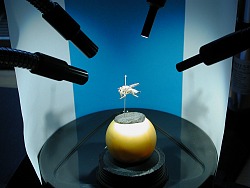 (1) Macro with cold light source
(1) Macro with cold light source
- macro mode: on
- internal flash: off
- set white balance or incandescent
- metering: spot
- perhaps expose compensation
- ISO 100
- exposure mode: P
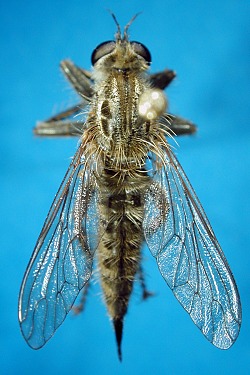
|
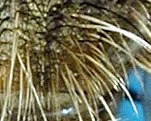
top: detail
original size
compression: 8%
left: dorsal view
image size: 25%
compression: 8%
|
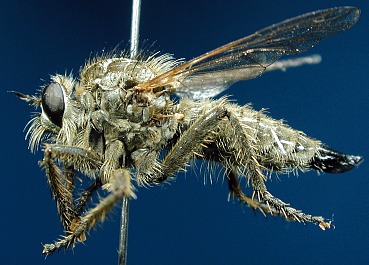
|

top: detail
original size
compression: 8%
left: lateral view
image size: 25%
compression: 8%
|
(2) Macro with 2 external flash lights and somewhat cold light
- connect external flash lights
- macro mode: on
- internal flash: off
- speedlight control: int flash off
- set white balance or incandescent
- metering: spot
- perhaps expose compensation
- ISO 50 emulation*
- exposure mode: M with 1/60 sec and F 8.8
- brightness varaiable by changing the distance of the 2 external flash lights
*ISO 50 emulation: set image adjustment on "less contrast" and use a higher expose compensation (+1)
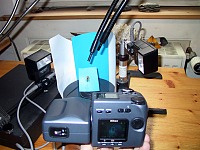
|
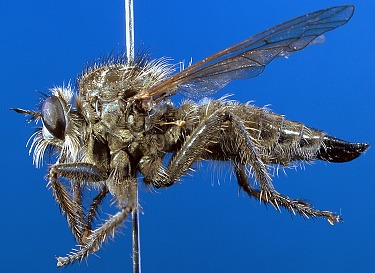
|
Result: depth of focus somewhat better than in (1)
(3) Macro with the Nikon Coollight SL-1
- connect the Nikon Coollight SL-1
- macro mode: on
- internal flash: off
- set white balance
- metering: spot
- perhaps expose compensation
- exposure mode: P
|
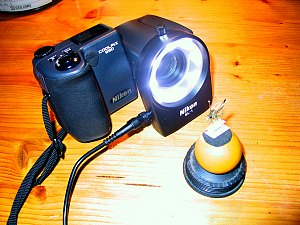
|
Result: A quick and cheap solution. The relative low luminous intensity is somewhat problematical (do not allow a small aperture). In addition it is very important to set the white balance. If you combine the Coollight and the external flash system, you will get problems with the colours. After 4 weeks of testing the Coollight in the museum, I prefer a combination of with a cold light source. The results are excellent. But be aware that this ring light can not be used for bigger insects (up to 1.5 cm).
I tested the Coollight also in the field. Sometimes it is very helpful, but you get trouble with the colour as well. Nevertheless I think that this light system is very helpful.
(4) Using a Raynox® MSN-500 Lens (macro 2.5x)
- settings like no. 2, except
full tele zoom is working also in macro mode
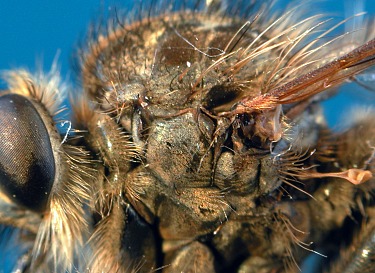
|
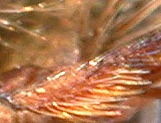
top: detail (base of wing)
original size
compression: 8%
left: lateral view
image size: 25%
compression: 8%
|
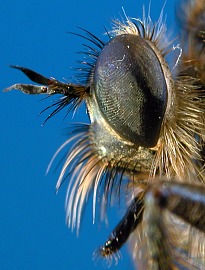
|
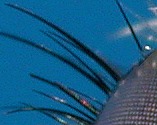
top: detail
original size
compression: 8%
left: lateral view
image size: 25%
compression: 8%
|
Result: much more details than in (1) and (2), but smaller depth of focus
(5) Using a binocular microscope [on the ocular lens, or with a special adapter]
- focus: infinity
- internal flash: off
- set white balance or incandescent
- metering: spot
- perhaps expose compensation
- ISO 100 or higher (if it is too dark)
- exposure mode: P or M
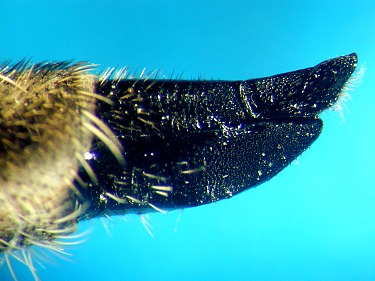
|
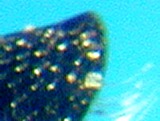
top: detail
original size
compression: 8%
left: ovipositor - lateral view
image size: 18%
compression: 8%
|
Result: much more details than in (1), (2), and (3), but no depth of focus
(6) Macro photographs with a Nikon® 3x Tele Converter TC-E3ED
- macro mode: on
- internal flash: off
- white balance: auto
- metering: spot or matrix
- perhaps expose compensation
- ISO 100 or auto
- exposure mode: P
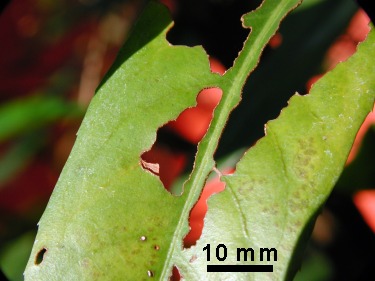
|
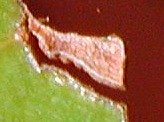
top: detail (leaf)
original size
compression: 8%
left: leaf (distance: 80mm)
image size: 18%
compression: 8%
|
Result: The use of the Tele Converter enables a higher distance to the object.
(7) Using a Nikon® 3x Tele Converter TC-E3ED
- usual settings, except:
optical zoom restricted to the higher sector (or follow the special instruction for additional tele converters)

|
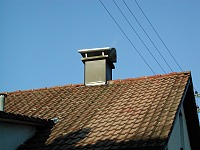
|
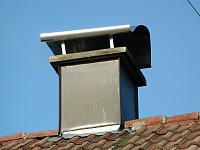
|
38mm
[without additional lens]
|
115mm
[without additional lens]
|
345mm
[with 3x Tele Converter]
|
(7) Using a Nikon® Coolpix 5700
I bought this camera for making images in the field (using the high zoom lens). Unfortunately winter is starting and I have to wait for the next spring. Nevertheless I can say that the 5700 is not a good help in the lab. (1st) You can not make such excellent photographs in macro mode, because of the higher distance between lens and the insect. (2nd) The manual focus is a joke, because you have no information on the distance (there is only a scroll bar). So you can not reproduce such an image. (3rd) In addition there is no possibility to make images on the eyepiece of the microscope without an adaptor. [By the way: I was able to read some notes on this camera in the WWW. It is true that the 5700 has great problems with the automatic focus inside darker rooms.]
(9) Links
- NEW
- Asilidae
- General
- Tele Lens Converters
- Macro Lens Converters
- Microscopy
- Lighting
- Software
|